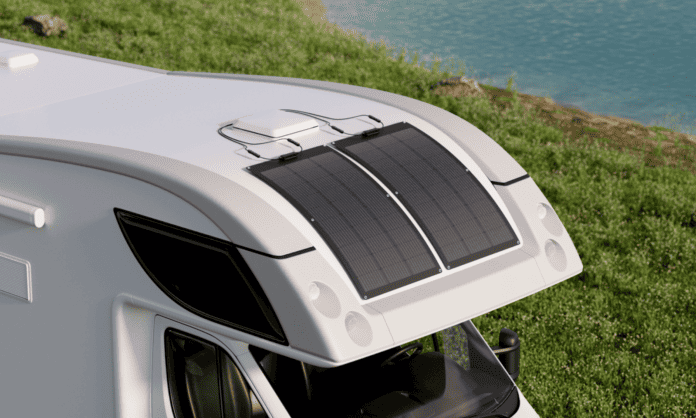Table of Contents
Flexible solar panel technology has improved dramatically in recent years. Thanks to their low cost and incredible versatility, flexible solar panels have become increasingly popular among outdoor enthusiasts.
Flexible solar panels are lightweight and easy to install, and their bendability is ideal for curved or irregular surfaces that you may find on RVs, boats, and yurts.
If you’re an outdoor enthusiast who owns an RV, you may wonder how to use flexible solar panels to your benefit.
Let us take a deep dive into everything you need to know about flexible solar panels and how they can benefit you and your RV lifestyle.
What Are Flexible Solar Panels?
Flexible solar panels are a type of solar panel that is designed to be flexible, lightweight, and moldable to curved or irregular-shaped surfaces. Their flexibility is due to the solar cells of the solar panel being encased in bendable plastic rather than covered in glass like rigid solar panels. Because of this bendability — up to 258° of flex for EcoFlow branded panels — flexible solar panels have become extremely popular for RV owners looking to maximize their limited space for electricity generation.
RV owners love flexible solar panels because they can easily be installed on curved surfaces to maximize the surface area of their RV to generate as much electricity as possible. The most common area where RV owners place flexible solar panels is the curved roof section, typically located above the cab (see picture above).
By placing flexible solar panels on the curved surfaces of an RV and combining them with additional rigid and portable solar panels, people who love to take their RVs off-grid can go wherever they please while knowing that they will be entirely self-sufficient and energy independent wherever they go.

What Are the Benefits of Flexible Solar Panels for RVs?
For RV owners, there are so many benefits to flexible solar panels that you would be unwise not at least to consider using them as part of your solar array.
Here are some benefits of flexible solar panels that have helped drive their popularity among outdoor enthusiasts.
Maximizes Available Surface Area
RV roofs come in all shapes and sizes, and often, there are a number of obstructions like AC units, satellite dishes, and vent ducts that need to be worked around when installing solar panels. Because flexible solar panels are bendable and smaller than rigid solar panels, they can be installed on curved surfaces and in smaller areas where larger rigid solar panels cannot.
With any RV, you have a finite amount of surface area to work with to generate the most electricity you can. With flexible solar panels, you can utilize surface area that you may not have been able to before to build the ultimate solar power system for your RV.
The best solar setup that maximizes the watt per square inch of your RV’s surface area will likely comprise a combination of rigid and flexible panels. Additionally, you can add one or more portable solar panels that you can set up once you reach your campsite. Remember, to tie the system together; you will also need a Power Kit, a portable power station, or other balance of the system to convert and store electricity.
Lightweight and durable
Another attractive feature of flexible solar panels is that they are lightweight and durable. Flexible solar panels can weigh up to 80% less than rigid solar panels. If you are looking to save on weight to improve fuel efficiency, then flexible solar panels may be a good option.
Also, lightweight, flexible solar panels are much easier to install on your own compared to larger and heavier rigid panels.
When it comes to durability, most flexible solar panels – like the EcoFlow 100W flexible panels, for example – are constructed from durable fibreglass and come with an IP68 rating. An IP68 rating means the panels are dust-resistant and water-resistant in fresh water to a depth of 1.5 meters for up to 30 minutes.
This means that your flexible solar panels will be protected from all types of extreme weather conditions like snow, ice, and severe thunderstorms.
Easy to install
Whereas rigid solar panels require installing brackets and drilling holes, flexible solar panels only require the use of industrial adhesives. Combined with their lighter weight, this makes flexible solar panels incredibly easy to install. Additionally, because of how flexible solar panels are mounted, they can easily be removed and applied to different surfaces depending on your needs.
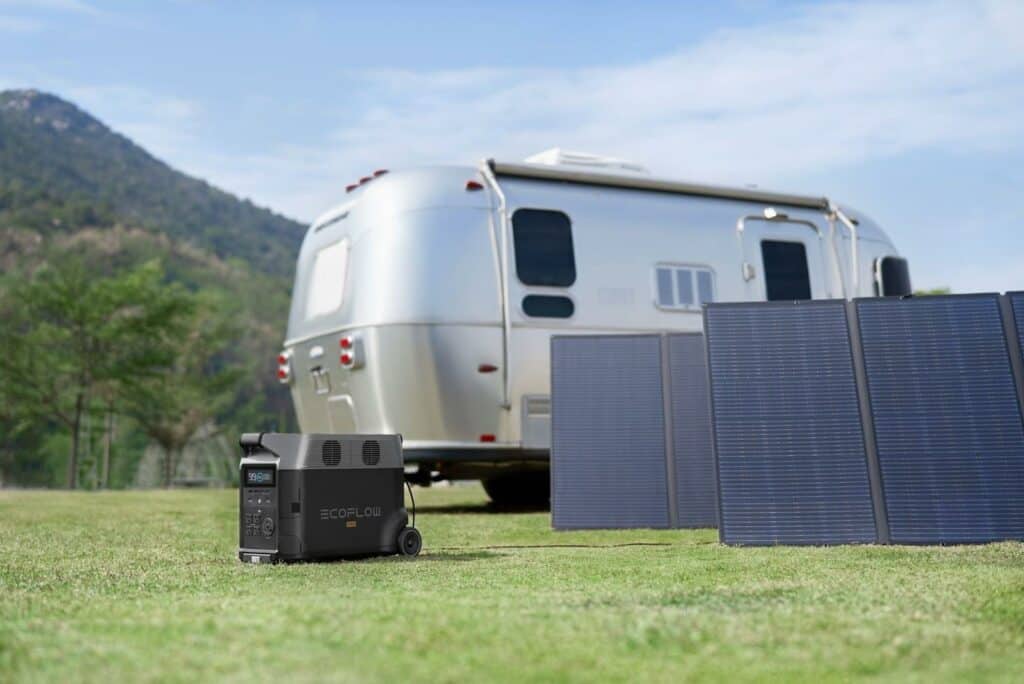
What Are the Disadvantages of Flexible Solar Panels for RVs?
Although it is undeniable that flexible solar panels come with many benefits, it is essential to consider the disadvantages as well. In some instances, and depending on your needs, flexible solar panels may not be the best option.
Here are some of the most common disadvantages RV owners have found when using flexible solar panels.
Less efficient
Generally speaking, flexible solar panels are less efficient than conventional rigid solar panels. The main reason for this is that flexible solar panels are thinner and contain less photovoltaic material than rigid solar panels.
On average, rigid panels have approximately 16% to 20% efficiency, and flexible panels have somewhere between 7% and 15%. However, as solar technology improves, we are starting to see flexible solar panels like EcoFlow’s reach efficiency rates of up to 23%, just like their rigid counterparts.
More expensive
If you break down the cost per watt, flexible solar panels, on average, typically cost more than rigid solar panels. That being said, since flexible solar panels are much easier to install, you may be able to make up for the price difference by installing flexible panels yourself. Often, when people are looking to install rigid solar panels, the amount of precision work required requires hiring a professional to complete the installation.
Lower lifespan
The average lifespan of flexible solar panels can be anywhere from 15 to 25 years, whereas rigid panels are designed to last between 25 and 40 years. That being said, if you are an RV owner who can get 15 to 25 years of reliable use out of a flexible solar panel, that may be more than enough for what you need.
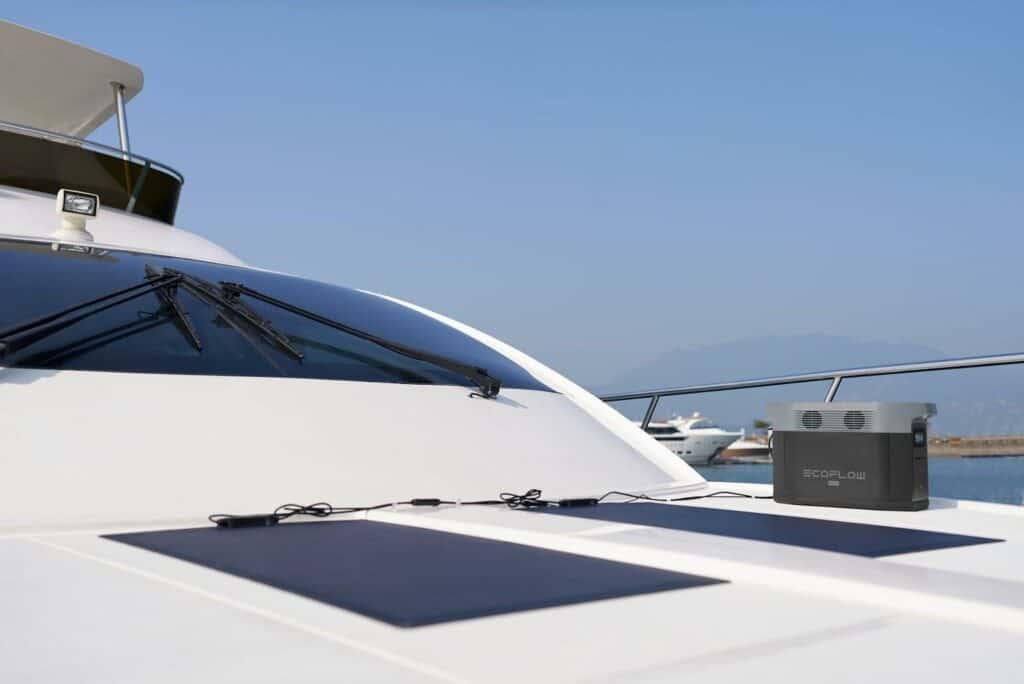
Factors To Consider When Choosing Flexible Solar Panels for Your RV
Alright, now that you’re convinced that purchasing a few flexible solar panels will complement your RV’s solar array nicely, where do you start?
How do you know if you are making a good purchase?
Here are some crucial factors to consider when choosing flexible solar panels for your RV.
Panel Type
The first thing you may want to consider when looking at flexible solar panels is the material they are constructed from. Each material type comes with its differences and its own set of pros and cons.
Here is a breakdown of the three most common materials used to construct solar panels.
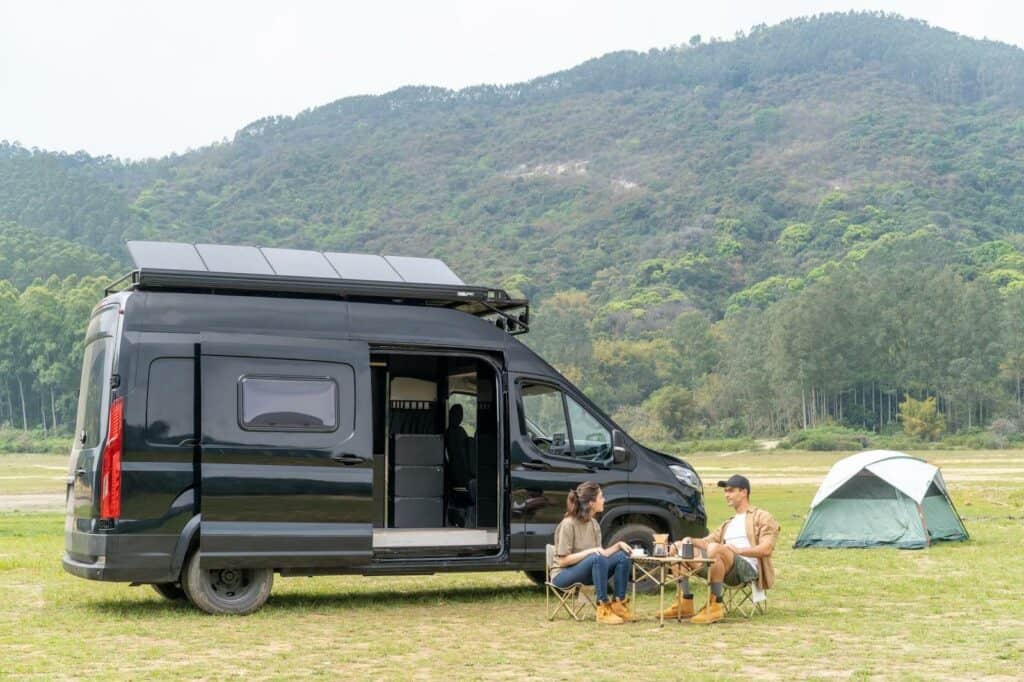
Monocrystalline panels
Monocrystalline solar cells are the most well-established solar panel material on the market.
Monocrystalline panels are known for their efficiency in all types of weather conditions as well as their longevity.
The main reason is that monocrystalline silicon is the most efficient photovoltaic material used in consumer solar panels. The cells are made from a single piece of pure silicon that efficiently converts sunlight into energy. Solar panels constructed with monocrystalline solar cells also tend to last longer and have life expectancies of up to 50 years.
Because of their higher efficiency and longevity — coupled with the fact that the construction process leads to wastage — solar panels constructed with monocrystalline solar cells tend to be the most expensive.
Pros
- High efficiency
- Require less space to generate more electricity
- More tolerant to higher temperatures
Cons
- Most expensive material
- Less sustainable to produce
Polycrystalline panels
Polycrystalline solar cells are also made from high-purity silicon crystals. However, the difference is that polycrystalline silicon crystals cool and break into several smaller fragments rather than maintaining a singular shape. The fragments are then melted at extreme temperatures and formed into cubes that are cut into thin slices.
The process of creating polycrystalline solar cells is by far less time-consuming and less expensive. This allows more cells to be produced in a shorter amount of time. The main shortfall of polycrystalline solar panels is that they are less efficient than monocrystalline panels. Generally, you’ll generate less electricity with a similar-sized poly PV panel than with a mono one.
Pros
- Less expensive and cheaper to produce
- Comparable lifespan to monocrystalline at a lower price
Cons
- Less efficient
- Less tolerant to heat
- Requires more space/panels to generate comparable wattage to a monocrystalline solar panel
Thin-film panels
Thin-film solar panels are typically made from one or more layers of amorphous silicon, cadmium telluride, gallium arsenide, or copper indium gallium selenide thin photovoltaic film. The solar cells that make up the film are often only one micron thick (0.001 mm). Thin-film panels, no matter the material, are easy to manufacture, making them a cheaper solar energy option.
Although thin-film panels are less efficient than monocrystalline and polycrystalline panels, they are less expensive, easier to install, and have a smaller carbon footprint because they require less semiconductor material.
Pros
- Lightweight and easy to install
- Lower carbon footprint
- Quicker ROI — or solar payback period — than other types of solar panels
Cons
- Lower efficiency
- More space required
- Not as readily available as other types of solar panels
- Lower life expectancy
Cost
Costs are another essential factor to consider. However, you need to look at more than just the sticker price when choosing solar panels. It is important to stick within a budget, but you should also consider other factors like efficiency, durability, and lifespan to determine the best choice for your solar installation. Ultimately, the more money you save on electricity over the long term, the wiser your investment.
Weight
Weight is something to consider if you are installing solar panels onto an RV since it ultimately affects fuel economy. Having multiple rigid solar panels on your RV’s roof will increase your vehicle’s weight much more than having a few flexible solar panels. If weight and fuel economy are a concern, you may want to consider seeing if you can meet all your energy needs with lightweight, flexible solar panels rather than rigid heavy ones.
Durability
Most solar panels are durable and constructed from solid materials, no matter the type. Solar panels must withstand extreme weather conditions, high temperatures, and powerful wind gusts. Since most solar panels will be durable, you may want to consider reading reviews about particular solar brands to see if there are any red flags about shoddy manufacturing.
Warranty
Last but certainly not least, check to see if the solar panels you are interested in come with some type of warranty. Some solar manufacturers can have warranties that last up to 25 years, depending on the material and panel type. Also, if the panels you are looking at do come with a warranty, make sure you understand what actions may void the warranty before purchasing them. You don’t want to attempt a DIY installation only to find you’ve unintentionally voided your warranty.
Frequently Asked Questions
Installing flexible solar panels on an RV is quite a simple process. For a complete guide to installing solar panels on your RV, check out this article from EcoFlow. Remember, if you have any doubts about your ability to install the panels yourself, it is best if you contact a professional.
Yes, flexible solar panels for an RV are worth it, especially if you are looking to maximize the surface area of your RV by combining rigid, flexible, and portable solar panels to produce enough electricity to meet all of your off-grid electricity needs.
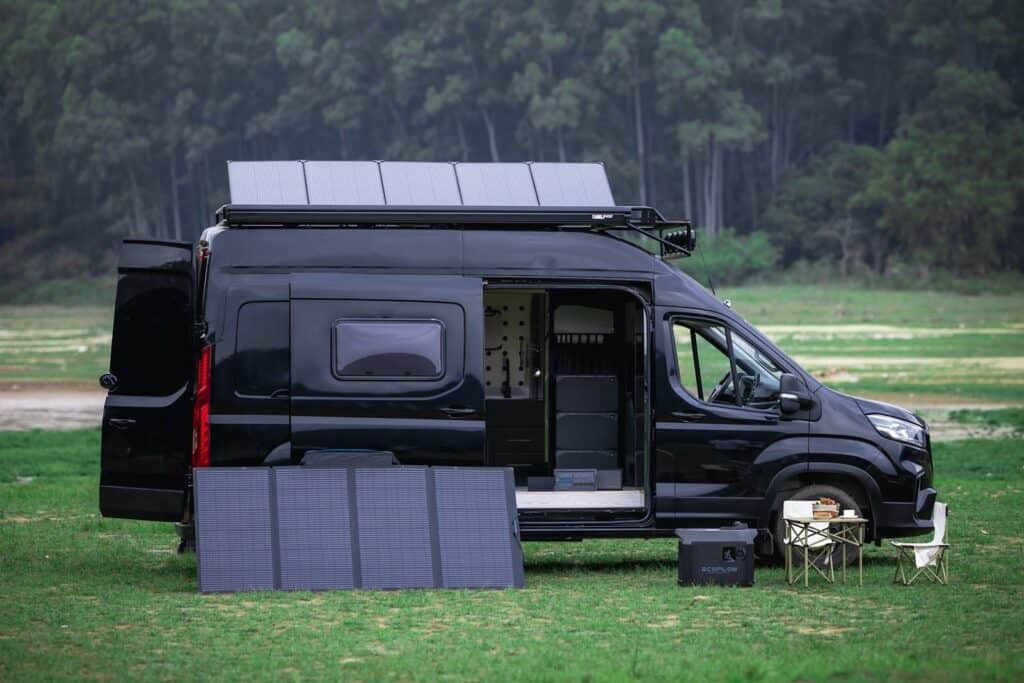
Final Thoughts
Flexible solar panels are perfectly designed to maximize the surface area of an RV roof to generate the highest amount of electricity possible with the space that is given.
By combining EcoFlow’s 100W flexible solar panels with other EcoFlow rigid and portable PV panels, you can achieve energy independence and feel free to set up camp anywhere without relying on shore power or electrical hookups.
Additionally, the lightweight construction and simple installation of flexible solar panels make them the perfect choice for anyone looking to save a few bucks on installation costs.
